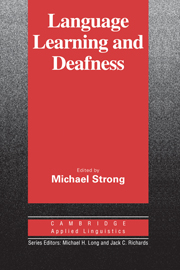Book contents
- Frontmatter
- Contents
- List of contributors
- Series editors' preface
- Preface
- SECTION I THEORETICAL ISSUES
- SECTION II RESEARCH REPORTS
- Chapter 6 An assessment of syntactic capabilities
- Chapter 7 Children's new sign creations
- Chapter 8 Linguistic and cultural role models for hearing-impaired children in elementary school programs
- Chapter 9 Acquiring linguistic and social identity: interactions of deaf children with a hearing teacher and a deaf adult
- Chapter 10 Development of vocal and signed communication in deaf and hearing twins of deaf parents
- Chapter 11 Questions and answers in the development of deaf children
- Index
Chapter 10 - Development of vocal and signed communication in deaf and hearing twins of deaf parents
Published online by Cambridge University Press: 05 October 2012
- Frontmatter
- Contents
- List of contributors
- Series editors' preface
- Preface
- SECTION I THEORETICAL ISSUES
- SECTION II RESEARCH REPORTS
- Chapter 6 An assessment of syntactic capabilities
- Chapter 7 Children's new sign creations
- Chapter 8 Linguistic and cultural role models for hearing-impaired children in elementary school programs
- Chapter 9 Acquiring linguistic and social identity: interactions of deaf children with a hearing teacher and a deaf adult
- Chapter 10 Development of vocal and signed communication in deaf and hearing twins of deaf parents
- Chapter 11 Questions and answers in the development of deaf children
- Index
Summary
Editor's introduction
Gaustad's research focuses on the special case of a pair of twins of deaf parents, one of whom is hearing, the other deaf. This is a particularly interesting scenario, with considerable theoretical importance, since the study of fraternal deaf-hearing twins provides a natural laboratory in which to consider questions of the role of modality versus handicap in the acquisition of language. Gaustad was interested in the effects of hearing status on the pragmatic effects of communication, communication mode, and language functions. She studied the twins as they interacted with each other and with deaf and hearing adults. Gaustad found that the hearing twin received more input than the deaf twin, that the parents code-switched to accommodate to the hearing status of the children, and that hearing status did not seem to affect the children's functional use of language. Furthermore, the children's output modality matched that of the parents quite consistently. This sensitivity to mode and hearing status of the interlocutor observed in both children and adults provides further evidence of the importance of deaf teachers in schools, both as sources of input and as role models for the children.
By adulthood, most deaf persons have attained some skills in both English and American Sign Language (ASL). Although English is required for literacy in a hearing society, sign language is the social and cultural bond within the Deaf community.
- Type
- Chapter
- Information
- Language Learning and Deafness , pp. 220 - 260Publisher: Cambridge University PressPrint publication year: 1988



